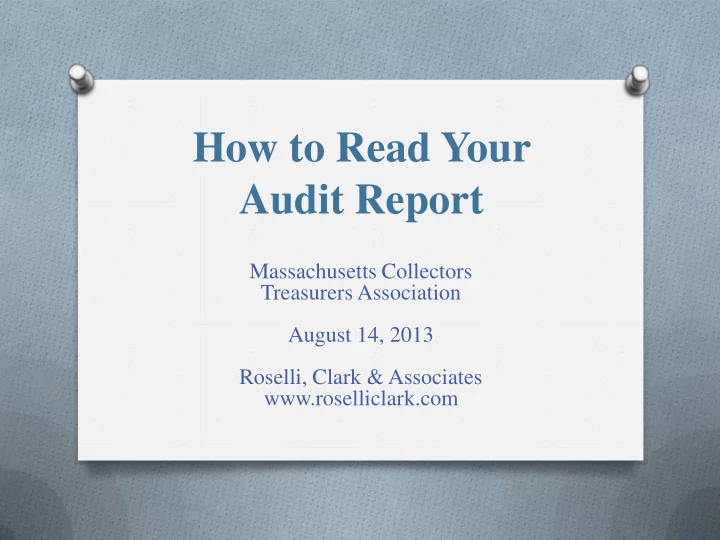

How to Read Your Audit Report Massachusetts Collectors Treasurers Association August 14, 2013 Roselli, Clark & Associates www.roselliclark.com
Contents Presenter: Chad Clark, Partner Tony Roselli, Partner What do financial statements represent? Who are the users of financial statements? Treasurer’s Role Financial Statement Contents 2
What Do Financial Statements Represent O Snapshot of where the community stands at the end of the fiscal year O Disclosure of revenues and expenditures for a fiscal year and how well a community performed O MD+A describes current year to prior year and why changes occurred O Footnote disclosures discuss major financial aspects of the community O Budget to actual – how well did we manage ourselves 3
Who Are The Users Of The Financial Statements O Bond Rating Agencies O Management O Oversight Agencies O Other Interested Parties 4
Bond Rating Agencies O Moodys O Standard and Poors O Fitch 5
Bond Rating Agencies O Assess credit worthiness O Assign rating O Part of bonding process and critical component to the cost of financing 6
Management O Finance Committee O Town Manager/Administrator O Board of Selectmen O Finance Director/Town Accountant O Treasurer/Tax Collector O School Business Manager O Superintendent O School Committee 7
Management O Assess trends O Maintain financial policies O Develop financial forecasts with focus on structural balance O Review budget results 8
Oversight Agencies O Department of Revenue - are there unreported deficits? - are they consistent with schedule A and balance sheet? - is reporting timely and accurately? O Various Federal and State Agencies - compliance with grant regulations 9
Other Interested Parties O Bond investors O Banks O Taxpayers 10
Treasurer’s Role O Treasurer should understand financial statements O Treasurer is a key contact for bond rating agencies O An important valuation metric is the qualifications and sophistication of Management. Understanding your financials helps in this regard - hanging up to ask your auditor and getting back to Bond Rater the next day is not desirable 11
Financial Statement Contents O Independent Auditor’s Report - audit opinion O Management’s Discussion and Analysis O Basic Financial Statements O Required Supplementary Information 12
Basic Financial Statements O Government-Wide Financial Statements O Fund Financial Statements - governmental funds - proprietary funds - fiduciary funds O Notes to Financial Statements 13
Major Financial Statement Components O Unassigned Fund Balance (reserve ratio) O Cash (liquidity) O Statement of Revenues and Expenditures (solvency) O Enterprise Funds O Budget to Actual Report (compliance) O Footnote Disclosures – Debt (liquidity) O Footnote Disclosures – OPEB (management of long term liabilities) 14
Unassigned Fund Balance - Reserve Ratio GASB 54 defines components of fund balance Unassigned Fund Balance = General Fund undesignated fund balances plus General Stabilization Fund Unassigned Fund Balance divided by budgeted expenditures = reserve ratio Important to bond rating 15
Unassigned Fund Balance - Reserve Ratio O > 10% = wish list – consider funding long term liabilities such as OPEB or Capital to avoid borrowings O 10% = high end metric O 6.7% = State average O 5.0% = low end metric O < 5.0% = Red Flag area 16
Unassigned Fund Balance - Reserve Ratio 10.0% 8.0% 6.0% 4.0% 2.0% 0.0% High end State average Low end metric metric 17
Cash Is the community liquid? Can we meet current obligations without stress? Should we consider moving to quarterly billing verses semi-annual? What are our investment policies (GASB 40)? Is cash insured or collateralized? – footnote disclosure 18
Statement of Revenues and Expenditures O Do revenues and other financing sources exceed expenditures? O Are we experiencing deficits? O How do we compare to the previous year? O How do we compare to other communities? - Electronic Municipal Market Access (EMMA) www.emma.msrb.org 19
Enterprise Funds O Do Enterprise Funds cover the cost of the activity? O Are there deficits that need to be raised? O Is debt covered by user charges? 20
Budget to Actual Report O How did we manage our expenditures? - what were our turn-backs O Did revenues exceed forecast? O Do we have deficits we need to raise? O How much did we rely on use of one-time funds? 21
Footnote Disclosures - Debt O Important to the bond rating agencies O Are we over leveraged (general rule is net debt after subsidies should be around 5% of budget) O What portion of debt is reimbursed by State (MSBA, MWPAT, etc.) O Use to plan future capital needs 22
Footnote Disclosures - OPEB O Management of long-term liabilities is becoming a critical component of the bond rating process O Does Town have an OPEB plan in place? O Has Town established an OPEB trust? (MGL Ch. 32B, Sec. 20) O Is Town funding OPEB liability? 23
Questions 24
Recommend
More recommend